|
|
|
Sort Order |
|
|
|
Items / Page
|
|
|
|
|
|
|
| Srl | Item |
| 1 |
ID:
128082
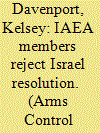

|
|
|
|
|
| Publication |
2013.
|
| Summary/Abstract |
A resolution critical of Israel's nuclear program, revived after a two-year hiatus, failed to pass the General Conference of the International Atomic Energy Agency (IAEA) last month. The nonbinding resolution, sponsored by a group of 18 Arab states, would have called on Israel to join the nuclear Nonproliferation Treaty (NPT) as a non-nuclear-weapon state and put all of its nuclear sites under comprehensive IAEA safeguards. The measure, referred to as "Israeli Nuclear Capabilities" on the IAEA agenda, failed by a vote of 43-51 on Sept. 20, the last day of the conference.
|
|
|
|
|
|
|
|
|
|
|
|
|
|
|
|
| 2 |
ID:
128084
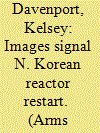

|
|
|
|
|
| Publication |
2013.
|
| Summary/Abstract |
Satellite images indicate that North Korea is restarting a nuclear reactor that could produce plutonium for nuclear weapons in the future, analysts say, but one of the analysts estimates it will be about 18 months before Pyongyang will have more plutonium available for weapons.
In a Sept. 11 piece published by 38 North, a website run by the U.S.-Korea Institute at Johns Hopkins University, Nick Hansen and Jeffery Lewis concluded that satellite images from Aug. 31 showed steam coming from a building near the reactor that was consistent in "coloration and volume" with bringing the reactor's electrical generating systems online. The reactor is "in or nearing operation," said Hansen, a former military imagery analyst, and Lewis, the director of the East Asia Nonproliferation Program at the James Martin Center for Nonproliferation Studies.
|
|
|
|
|
|
|
|
|
|
|
|
|
|
|
|
| 3 |
ID:
128081
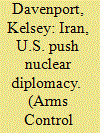

|
|
|
|
|
| Publication |
2013.
|
| Summary/Abstract |
Following a high-level series of diplomatic exchanges and meetings between U.S. and Iranian leaders in late September, both sides say there is a strong basis for a diplomatic resolution to the long-running impasse over Iran's nuclear program. In the highest level of contact between the two governments since 1979, President Barack Obama and Iranian President Hassan Rouhani spoke by telephone about Iran's nuclear program Sept. 27, Obama told reporters at a White House news conference later that day. "While there will surely be important obstacles" and success is not guaranteed, "I believe we can reach a comprehensive solution" to the dispute over Tehran's nuclear program, Obama said.
|
|
|
|
|
|
|
|
|
|
|
|
|
|
|
|
| 4 |
ID:
128083
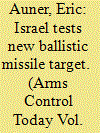

|
|
|
|
|
| Publication |
2013.
|
| Summary/Abstract |
Israel on Sept. 3 conducted the first flight test of a new missile defense target designed to improve Israeli defenses against longer-range ballistic missiles. The unannounced launch of the target, designed to simulate medium-range ballistic missiles like those possessed by Iran, was detected by Russian radar and reported in Russian media.
Israel, which initially claimed that it was unaware of a missile launch over the Mediterranean Sea after it was reported in the Russian media, said the test of the Silver Sparrow ballistic missile defense target was long planned. The Israeli Ministry of Defense issued a statement on its Facebook page saying that the missile defense radar successfully detected and tracked the launch and transferred flight data to the battle management system.
|
|
|
|
|
|
|
|
|
|
|
|
|
|
|
|
| 5 |
ID:
128087
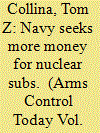

|
|
|
|
|
| Publication |
2013.
|
| Summary/Abstract |
Warning that ongoing defense spending cuts will have a "devastating impact" on its plans to build new ships, the Navy is asking Congress for an additional $60 billion over 15 years to pay for a dozen new nuclear-armed submarines. Testifying Sept. 12 before the House Armed Services Seapower Subcommittee, Rear Adm. Richard Breckenridge, the Navy's director of undersea warfare, said that the Navy's projected shipbuilding budget cannot afford to pay for the 12 new submarines, known as the SSBN(X). These new boats are to replace the existing fleet of nuclear-armed Ohio-class subs, which the Navy plans to start retiring in 2027. "Congress must look at a way to provide an annual supplement to the Navy" during the time that construction costs will peak, Breckenridge said. The Navy is seeking $4 billion per year over the 15-year period that the new subs would be built, starting in 2021. Breckenridge said that the SSBN(X) should be looked at as "a requirement above the Navy" that should be insulated from "the pressures of sequestration."
|
|
|
|
|
|
|
|
|
|
|
|
|
|
|
|
| 6 |
ID:
128085
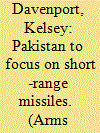

|
|
|
|
|
| Publication |
2013.
|
| Summary/Abstract |
Pakistan is likely to remain focused on developing and improving short-range ballistic missiles and cruise missiles to deter India's conventional military superiority despite the second successful test of India's long-range, nuclear-capable Agni-5 missile, experts said in recent interviews.
Although India and Pakistan are nuclear rivals, New Delhi's forays into longer-range missile systems do not seem to be spurring reciprocal developments in Islamabad.
|
|
|
|
|
|
|
|
|
|
|
|
|
|
|
|
| 7 |
ID:
128080


|
|
|
|
|
| Publication |
2013.
|
| Summary/Abstract |
The UN Security Council on Sept. 27 unanimously adopted a plan for destroying Syria's chemical arsenal, endorsing a blueprint that the Executive Council of the Organisation for the Prohibition of Chemical Weapons (OPCW) had approved a few hours earlier. The actions by the 41-member Executive Council, which generally operates by consensus, and the 15-member Security Council establish timelines for the destruction of Syria's chemical weapons. The two councils were building on a framework agreement for control and elimination of Syria's arsenal concluded by Russian Foreign Minister Sergey Lavrov and U.S. Secretary of State John Kerry on Sept. 14 after days of intensive bilateral negotiations in Geneva. The two council decisions spell out ways in which the United Nations and the OPCW are to coordinate in overseeing Syria's chemical disarmament. The documents approved by the two councils cite Article VIII of the Chemical Weapons Convention (CWC), which says that the Executive Council should refer compliance issues "of particular gravity and urgency" to the Security Council. The OPCW is the international body that implements the CWC.
|
|
|
|
|
|
|
|
|
|
|
|
|
|
|
|
| 8 |
ID:
128079


|
|
|
|
|
| Publication |
2013.
|
| Summary/Abstract |
The U.S.-Russian agreement on Syria's chemical weapons is a recent, powerful reminder of the extraordinary value of arms control. An arduous process to find and destroy the chemical arsenal of Syrian President Bashar al-Assad lies ahead. Yet, it is made much simpler by the aggregation of expertise and baseline of protocols and procedures under the Chemical Weapons Convention (CWC), which was negotiated under President George H.W. Bush and ratified under President Bill Clinton. Imagine the difficulty of starting this effort without those assets. Why then is the United States degrading its capability to design, negotiate, and lead efforts to enforce agreements such as the CWC? In late 1999, the independent U.S. Arms Control and Disarmament Agency (ACDA) was folded into the Department of State, a process in which I was deeply involved as ACDA's last director. I had high hopes for the reorganization. While creating an institutional home in a larger, more powerful agency, the plan on which ACDA and the State Department had agreed, with congressional approval, preserved ACDA's two most irreplaceable assets-an independent voice for arms control and nonproliferation priorities at the highest levels of the government and protection of job security and career opportunities for the technical experts whose skills and insights were indispensable to success.
|
|
|
|
|
|
|
|
|
|
|
|
|
|
|
|
| 9 |
ID:
128077
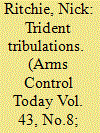

|
|
|
|
|
| Publication |
2013.
|
| Summary/Abstract |
The United Kingdom's nuclear weapons policy is in flux as the country debates whether to replace its current Trident strategic nuclear weapons system and remain in the nuclear weapons business for another generation. Choices about nuclear weapons are certain to feature in the next general election in May 2015. The debate is deeply political and parochial, but also involves a much broader set of issues related to nuclear deterrence and steps toward nuclear disarmament. Some of this debate came to a head with the publication of the government's "Trident Alternatives Review" in July.[1] This article examines the political issues surrounding the report and sets them in the broader context of deterrence and disarmament.
|
|
|
|
|
|
|
|
|
|
|
|
|
|
|
|
| 10 |
ID:
128086
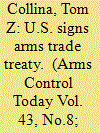

|
|
|
|
|
| Publication |
2013.
|
| Summary/Abstract |
The United States and 17 other countries signed the Arms Trade Treaty (ATT) on Sept. 25, pushing the number of signatories to the pact, which was opened for signature June 3, to 107.
Calling it a significant step toward controlling the illicit trade in conventional weapons, Secretary of State John Kerry signed the treaty on behalf of the United States, the world's largest arms exporter, in a ceremony at the United Nations. "This is about keeping weapons out of the hands of terrorists and rogue actors," Kerry said.
"It's significant that the United States, which [accounts] for about 80 percent of the world's export in arms, has signed," Australian Foreign Minister Julie Bishop told a news conference. In 2012, states engaged in arms transfers totaling more than $85 billion, not including black market transfers, according to the Congressional Research Service.
|
|
|
|
|
|
|
|
|
|
|
|
|
|
|
|
|
|
|
|
|